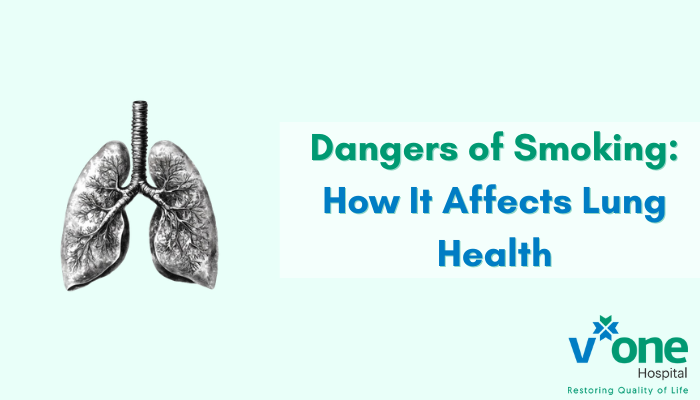The Dangers of Smoking: How It Affects Lung Health
Smoking is one of the leading causes of preventable disease and death worldwide. While most people are aware that smoking is “bad for health,” many don’t fully understand how significantly it affects lung function and overall wellbeing. Your lungs are responsible for supplying oxygen to every cell in your body — but when they are exposed to harmful chemicals from cigarettes, their ability to do this job decreases dramatically.
In this blog, we will explore how smoking damages your lungs, the diseases it can cause, and why quitting smoking is one of the most important steps you can take toward better health.
What Happens When You Smoke
When you inhale cigarette smoke, you’re breathing in a mix of more than 7,000 chemicals — many of which are toxic, and at least 70 of them are known to cause cancer. These chemicals include nicotine, tar, carbon monoxide, formaldehyde, and arsenic.
Your lungs, lined with delicate air sacs (alveoli) and tiny hair-like structures called cilia, are designed to keep the air clean and facilitate oxygen exchange. Smoking damages these natural defenses.
- Cilia damage: Cilia normally sweep out mucus, dust, and germs from the airways. Smoking paralyzes and eventually destroys these cilia, allowing toxins to accumulate.
- Inflammation and irritation: The chemicals in smoke irritate the airways, causing chronic inflammation and narrowing of the air passages.
- Reduced oxygen levels: Carbon monoxide in cigarette smoke binds to red blood cells more effectively than oxygen, which reduces the amount of oxygen reaching vital organs.
Smoking and Chronic Lung Diseases
The most significant impact of smoking is seen in the form of chronic lung diseases. Some of the most common conditions linked to smoking include:
1. Chronic Obstructive Pulmonary Disease (COPD)
COPD is a group of progressive lung diseases, including chronic bronchitis and emphysema. Smoking is the leading cause of COPD, responsible for nearly 90% of cases.
- Chronic bronchitis: Smoking causes the airways to become inflamed, leading to persistent cough and excess mucus production.
- Emphysema: The delicate air sacs in the lungs are destroyed, reducing the lung’s ability to exchange oxygen and carbon dioxide. This causes shortness of breath that worsens over time.
COPD is irreversible, but quitting smoking can slow down its progression and improve quality of life.
2. Lung Cancer
Lung cancer is the most deadly cancer worldwide, and smoking is its number one cause. In fact, smokers are 15 to 30 times more likely to get lung cancer compared to non-smokers.
The carcinogens in cigarettes damage the DNA of lung cells, causing them to grow abnormally and form tumors. Even secondhand smoke can significantly increase lung cancer risk in non-smokers.
3. Increased Risk of Infections
Smoking weakens your immune system, making it harder for your body to fight infections. Smokers are more prone to pneumonia, tuberculosis, and influenza.
Smoking and Overall Lung Function
Even if you do not develop COPD or lung cancer, smoking still reduces your overall lung health and function. Over time, you may notice:
- Frequent coughing and wheezing
- Shortness of breath after mild exertion
- Reduced exercise tolerance
- Slower recovery from respiratory illnesses
Your lungs naturally lose some function as you age, but smoking accelerates this process — often leading to noticeable breathing problems decades earlier than in non-smokers.
Secondhand Smoke: A Silent Threat
Even if you don’t smoke, exposure to secondhand smoke can be harmful to your lungs. Secondhand smoke contains the same toxic chemicals as inhaled smoke, and regular exposure increases the risk of lung cancer, asthma attacks, and other respiratory problems — especially in children and the elderly.
The Benefits of Quitting Smoking
The good news is that it is never too late to quit smoking. The lungs have an incredible ability to heal when given a chance. Here’s how your body begins to recover after you stop smoking:
- 20 minutes after quitting: Heart rate and blood pressure drop.
- 12 hours after quitting: Carbon monoxide levels in the blood return to normal.
- 2 weeks to 3 months after quitting: Lung function begins to improve, and circulation gets better.
- 1 to 9 months after quitting: Coughing and shortness of breath decrease as cilia regrow in the lungs.
- 1 year after quitting: The risk of coronary heart disease is cut in half compared to a smoker.
Quitting smoking not only improves lung health but also boosts overall well-being and significantly increases life expectancy.
Tips to Quit Smoking
Quitting smoking is not easy, but it is absolutely achievable with the right support and strategies:
- Set a quit date: Choose a specific day and prepare yourself mentally.
- Seek professional help: Your pulmonologist in Indore can recommend nicotine replacement therapy, prescription medications, or counseling.
- Identify triggers: Avoid situations that tempt you to smoke and replace smoking habits with healthy alternatives.
- Join a support group: Being around others who are on the same journey can boost motivation.
- Stay persistent: Relapses can happen, but don’t give up — every attempt brings you closer to quitting for good.
Conclusion
Smoking is one of the biggest threats to lung health, but it is also one of the most preventable. By understanding how smoking damages your lungs and taking steps to quit, you can significantly lower your risk of chronic diseases, breathe easier, and live a longer, healthier life.
Your lungs are your body’s life engine — protect them by making the decision to quit smoking today. Your future self will thank you.

